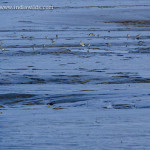Local stakeholders’ participation: Key to protecting the Himalayan Rivers?
The Indian Himalayan Rivers are a life-line for millions yet, facing severe threats. Can local stakeholders’ participation to conserve riverine ecosystems help in alleviating some of the threats?
India is a land of diversity with abundant floral and faunal species. It is also blessed with numerous perennial rivers. Further, the country has different bio-geographic zones each with diverse climatic conditions, and the Indian Himalayas is one of them. Apart from being a biodiversity hotspot, the Himalayan region is also the source of major perennial rivers. Some of these rivers are not only pilgrimage sites among devotees, but also provide multiple ecological and economic benefits. Millions of people also rely on these Himalayan Rivers in the downstream reaches as these rivers create vast fertile plains here and help sustain local livelihoods. More importantly, the Himalayan Rivers are home to a number of fish species. Apart from having various ecological functions, these fish species are at times the only source of protein for some poorer sections of the Indian society.
Anthropogenic stressors:
Despite these benefits, there are various anthropogenic stressors that are threatening the survival of the Himalayan Rivers and their fish species. To begin with, there is a huge demand for water from these rivers due to a growing population and a surge in industrial activities and constructions in the region. The construction activities lead to huge increase in demand for boulders and sand leading to illegal boulder and sand mining of rivers. This inturn impacts the percolation, ability of the river to cleanse and virtually destroys the river.
With the increase in population, the dumping of domestic and industrial waste into the rivers has skyrocketed leading to severe degradation in the quality of water. The creation of barriers to divert water flows reduces the flow of the river and impacts its capacity to cleanse. The removal of riparian vegetation to make way for new agricultural and urban land along with the destruction of river beds by illegal sand and boulder mining reduces the species richness by severely degrading the riverine ecosystem. The use of illegal fishing techniques such as dynamite fishing and poisoning to catch the fishes kills many other species apart from the fishes preferred in the market and damages the rivers. The combined effect of all these activities is acting like a death knell for these rivers.
Conservation and Stakeholder support:
There are numerous conservation strategies currently in place to protect river ecosystems here. However, not all of them are achieving the desired and long-term targets as anticipated during their implementation. One of the key barriers to the successful implementation of any conservation policy is the lack of local stakeholders’ support, which has the potential to greatly undermine its aim and objectives. Therefore, any conservation plan can benefit by being sympathetic to the desires and hesitations of local stakeholders. There are possible approaches that could further assist the ongoing river and fish conservation programmes in the region.
Community governed
One such plan to protect Himalayan Rivers and their fishes could be to legislatively create community-governed river reaches. For example, communities located along a river could manage and protect river reaches abutting the community geographical boundaries, with adequate encouragement, support and under the overall jurisdiction of the appropriate Government authorities. However, assessing local communities’ willingness to support such an approach has to be made a priority. The key members of the community also need to be trained so that the community is able to understand their duties and handle the responsibility. Even though a community is willing and is capable, after passage of time the initial enthusiasm can subside. Utmost care has to be taken to avoid conflicts of interest between communities which could hinder the success of this approach. Communities enthusiastic to support the approach should be allowed to assist with the ongoing conservation strategies in the region to better understand the future requirements and commitments from them. There are other potential hurdles with this approach, e.g. the unwillingness of neighbouring communities to participate in river and fish conservation as well as conservation of the riverine ecosystem in a holistic manner. Here educational awareness and media could play a pivotal role. Communities protecting multiple river reaches along a river could have the potential for a long-term catchment scale protection.
Flagship species have been vital in spreading conservation awareness and generating funds for future research activities. This has benefitted the species in question and their ecosystem. In the Himalayan region, the tiger and the Indian elephant continue to play important flagship roles and secure their survival and that of their habitats. Therefore, there is a need to explore the possibility of a flagship fish species which could boost river conservation on a domestic and international scale. However, such fish species should have strong local stakeholders’ support by providing social and economic benefits. The golden mahseer could be investigated as a candidate for such an approach. This is because this fish species is world renowned among catch-and-release (C&R) anglers, who frequent the Himalayan Rivers in its search. This brings with it economic opportunities for local stakeholders, but more importantly, a sense of local pride for village members.
Catch and Release (C&R) angling has been a leisure activity in the Himalayan region for many decades, and has attracted both domestic and international audience. Various fish species have been of interest; however, the golden mahseer has been a clear winner. There are strong views that Catch and Release (C&R) angling is detrimental for not just the target fish species, but also for the wider river ecosystem. It is not permitted in the PAs (Protected Areas), Wildlife Sanctuaries and National Parks. There are reports of C&R angling providing valuable fish data to scientists, generating funds for research projects, providing monetary incentives for regional economies, and through collaboration with local stakeholders ensuring protection to threatened fish species. In this regard, there is a need to study the level of conservation awareness among C&R anglers visiting the Himalayan Rivers, and then determine if their current and future assistance could benefit the fish species as well as protection of the riverine ecosystem outside our existing PAs (protected areas) and Wildlife Sanctuaries.
The Indian Himalayan Rivers are facing major turmoil and demand the application of multiple approaches. The health of a river will be good if the entire river is protected through multiple mechanisms like existing PAs (Protected Areas), WLS (Wildlife Sanctuaries), National Parks along with community participation. Importantly, unless there is widespread cooperation between local stakeholders, we will be fighting a losing battle. The time has come to act, and to act now.
- The Valley of the Divine Bhagirathi - 28 July,2015
- Can Mass media help in Conserving Mahseer & Riverine Ecosystem? - 26 June,2014
- Local stakeholders’ participation: key to protecting the Himalayan Rivers? - 24 March,2014












The Golden Mahseer looks so picture friendly,and yes! You have written a great article.I hope their effort helps in conservation.
Thank you very much 🙂
You are right, without support from local stakeholders, conservation is a really uphill task. Good informative article.
I know what you are talking about. This is one reason, sand collection is prohibited in my region. Though, it has impacted the livelihood of many. It seems to be something on which government should seriously work. Banning something without giving alternate means of livelihood to locals won’t help.
Hi Saru, I wonder if those who are taking sand illegally would be prepared to face the consequences of their actions?
Yep, I have every sympathy for those who are at the bottom of the social heap trying to claw an existence and would, absolutely, want to try to offer them an alternative way to make a living. But, the reality is many who do these things are not locals, they are very often part of a criminal gang who exploit resources mindlessly (in my experience on the southern rivers).
The damage they do is on a par with illegal logging, it has as much impact on local populations as does a large mining company ripping out iron ore without permission. Next time there is a devastating flood on one of these rivers, perhaps we should think about all those who have caused the misery?
Thank you Rachna 🙂 Well said Saru…
Really informative article.. its food for thought!
Thank you Aditi 🙂
Good little article Nish.
Thank you Steve 🙂